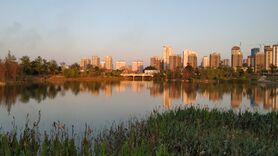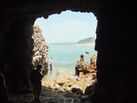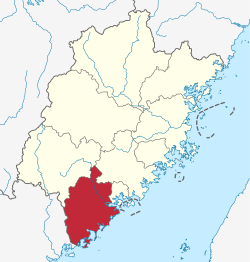ژانگژو
| ||||||||||||||||||||||||||||||||||||||||||||||||||||||||||||||||||
| ||||||||||||||||||||||||||||||||||||||||||||||||||||||||||||||||||
ژانگژو/تشانغ تشو ( Zhangzhou ؛ /ˈdʒæŋˈdʒoʊ/) هي مدينة بمستوى محافظة في مقاطعة فوجيان، الصين. المحافظة المحيطة بالمدينة تتألف من الركن الجنوبي الشرقي للمقاطعة، تطل على مضيق تايوان و (مع Quanzhou) تحيط بمحافظة شيامن.
الاسم
Zhangzhou is the atonal pinyin romanization of the city's Chinese name 漳州, using its pronunciation in Standard Mandarin.[3] The name derives from the city's former status as the seat of the imperial Chinese Zhang Prefecture. The same name was romanized as Changchow on the Chinese Postal Map and Chang-chou in Wade-Giles. Other romanizations include Chang-chow.[4]
It also appears as Chang-chu,[5] Chiang-chew, or Chiang Chew[بحاجة لمصدر] from the city's local Hokkien name Chiang-chiu.[6] This name appeared in Spanish and Portuguese Jesuit sources as Chincheo, which was anglicized as Chinchew. By the 19th century, however, this name had migrated and was used to refer to Quanzhou, a separate port about 65 miles (105 km) east-northeast of central Zhangzhou.[7]
التاريخ
According to Odoric of Pordenone, Zhangzhou was a prosperous city twice the size of Bologna.[8]
During the early Qing, Zhangzhou was the primary Fujianese port trading with Portuguese Macao and Spanish Manila. For a time, the Portuguese maintained a factory in the city.[7]
During the late Qing, Zhangzhou remained a center of silk, brick, and sugar production with about a million people and extensive internal and maritime trade. Its city wall had a circumference of about 4.5 miles (7.2 km) but included a good deal of open ground and farmland. Its streets were paved with granite but badly maintained. The 800-foot (240 m) bridge across the Jiulong River consisted of wooden planks laid between 25 piles of stones at roughly equal intervals.[4] The port of Xiamen in an island at the mouth of the Jiulong principally functioned as a trading center for the produce and wares of Zhangzhou and its hinterland;[5] both suffered economically when Indian tea plantations cratered demand for Fujianese tea in the late 19th century.[9]
من 1864 حتى 1865، Li Shixian، والي مملكة تايپنگ السماوية، أرسى سلطة سياسية في ژانگژو .
In the early years of the Republic of China, it belonged to Tingzhang Road , and then the road was withdrawn. Each county was directly under the jurisdiction of the province, and administrative supervision areas were established.
From September 1918 to August 1920, Zhangzhou was the political center of the Southern Fujian Guardian District established by تشن جيونگمينگ.
 خريطة سيطرة منطقة حرس جنوب فوجيان. |
From July 1923 to February 1924, Huang Dawei, the Chaoshan Border Defense Supervisor appointed by Chen Jiongming , together with the Gan Army general Lai Shihuang (attached to Chen Jiongming), the Gui Army general Liu Zhilu , and Li Houji's old subordinate Wang Xianchen established the " Allied Forces Office " regime in Zhangzhou [5] . After the collapse of the "Allied Forces Office" regime, warlord Zhang Yi ruled the Zhangzhou area until November 17, 1926. From 1928 to 1932, the Zhangzhou area was ruled by the warlord Zhang Zhen .
المدينة القديمة في ژانگژو (now Xiangcheng District) was occupied in April and May 1932 by a column of Communist guerrillas under Mao Zedong. Due to the presence of Western gunboats in Xiamen Bay, arms shipments from the Soviet Union were unable to get up the Jiulong River to Mao's forces and the main Communist bases. Discovering this, Mao retreated from the city, according to some accounts with a substantial amount of loot taken from its residents.[10]
الجغرافيا
Zhangzhou proper lies on the banks of the Jiulong River in southern Fujian about 35 miles (56 km) from central Xiamen,[4] whose urban core has grown to form a single urbanized area with it. The prefecture of Zhangzhou comprises the southeastern corner of the province, surrounding Xiamen. The prefecture of Quanzhou lies to its northeast, Longyan to its northwest, and Shantou in Guangdong to its southwest.
المناخ
Zhangzhou has a monsoon-influenced humid subtropical climate (Köppen Cfa), with mild to warm winters and long, very hot and humid summers. The monthly 24-hour average temperature ranges from 13.2 °C (55.8 °F) in January to 28.8 °C (83.8 °F) in July, and the annual mean is 21.3 °C (70.3 °F). The frost-free period lasts 330 days.
| Climate data for ژانگژو (1991–2020 normals, extremes 1971–2000) | |||||||||||||
|---|---|---|---|---|---|---|---|---|---|---|---|---|---|
| Month | Jan | Feb | Mar | Apr | May | Jun | Jul | Aug | Sep | Oct | Nov | Dec | Year |
| Record high °C (°F) | 28.8 (83.8) |
30.3 (86.5) |
33.7 (92.7) |
35.1 (95.2) |
37.5 (99.5) |
37.6 (99.7) |
38.6 (101.5) |
38.1 (100.6) |
37.1 (98.8) |
34.6 (94.3) |
35.2 (95.4) |
29.1 (84.4) |
38.6 (101.5) |
| Mean daily maximum °C (°F) | 18.7 (65.7) |
19.4 (66.9) |
21.7 (71.1) |
26.0 (78.8) |
29.2 (84.6) |
31.9 (89.4) |
34.3 (93.7) |
33.9 (93.0) |
32.2 (90.0) |
29.0 (84.2) |
25.3 (77.5) |
20.8 (69.4) |
26.9 (80.4) |
| Daily mean °C (°F) | 14.1 (57.4) |
14.7 (58.5) |
17.0 (62.6) |
21.2 (70.2) |
24.8 (76.6) |
27.6 (81.7) |
29.4 (84.9) |
28.9 (84.0) |
27.6 (81.7) |
24.3 (75.7) |
20.5 (68.9) |
16.0 (60.8) |
22.2 (71.9) |
| Mean daily minimum °C (°F) | 11.0 (51.8) |
11.8 (53.2) |
13.9 (57.0) |
18.0 (64.4) |
21.8 (71.2) |
24.7 (76.5) |
26.0 (78.8) |
25.6 (78.1) |
24.3 (75.7) |
20.8 (69.4) |
17.0 (62.6) |
12.6 (54.7) |
19.0 (66.1) |
| Record low °C (°F) | 1.3 (34.3) |
1.3 (34.3) |
3.0 (37.4) |
7.3 (45.1) |
12.3 (54.1) |
17.0 (62.6) |
21.0 (69.8) |
21.3 (70.3) |
16.8 (62.2) |
7.6 (45.7) |
4.8 (40.6) |
−0.1 (31.8) |
−0.1 (31.8) |
| Average precipitation mm (inches) | 46.3 (1.82) |
70.8 (2.79) |
106.9 (4.21) |
128.3 (5.05) |
199.2 (7.84) |
270.1 (10.63) |
198.5 (7.81) |
263.8 (10.39) |
175.5 (6.91) |
56.0 (2.20) |
42.0 (1.65) |
46.8 (1.84) |
1٬604٫2 (63.14) |
| Average precipitation days (≥ 0.1 mm) | 7.6 | 10.1 | 13.5 | 13.1 | 15.8 | 18.0 | 11.8 | 14.9 | 10.7 | 4.4 | 5.2 | 6.3 | 131.4 |
| Average relative humidity (%) | 72 | 75 | 76 | 76 | 78 | 80 | 75 | 77 | 73 | 67 | 69 | 69 | 74 |
| Mean monthly sunshine hours | 130.4 | 101.5 | 102.9 | 118.3 | 131.4 | 147.3 | 219.6 | 195.6 | 178.9 | 182.0 | 156.9 | 146.8 | 1٬811٫6 |
| Percent possible sunshine | 39 | 32 | 28 | 31 | 32 | 36 | 53 | 49 | 49 | 51 | 48 | 45 | 41 |
| Source 1: China Meteorological Administration[11][12] | |||||||||||||
| Source 2: Weather China[13] | |||||||||||||
التقسيمات الإدارية
| الخريطة |
|---|

|
Zhangzhou comprises 4 urban districts, and 7 counties.
- Xiangcheng District (芗城区)
- Longwen District (龙文区)
- Longhai District (龙海区)
- Changtai District (长泰区)
- Dongshan County (东山县)
- Hua'an County (华安县)
- Nanjing County (南靖县)
- Pinghe County (平和县)
- Yunxiao County (云霄县)
- Zhangpu County (漳浦县)
- Zhao'an County (诏安县)
السكان
During the 2020 Chinese census, the entire area of Zhangzhou was home to 5,054,328 inhabitants. Along with the 2,120,178 people of central Xiamen, its urban districts of Xiangcheng, Longwen, Longhai and Changtai, form a single metropolitan area of about 7,284,148 people.
The main language of the Zhangzhou Hokkiens is the local dialect of Min Nan, part of the Southern Min branch of Min Chinese. Government, education, and official business, however, are carried out in Mandarin.[citation needed]
Hakka is also spoken in the rural peasant area of Zhangzhou in the west and south.
الاقتصاد
Babao seal paste was invented by the druggist Wei Changan as a traditional medicine in 1673. It was repurposed for artistic use a few years later and gained imperial favor under the Qianlong Emperor. It remains prized for its bright color and pleasant smell.
A major petrochemical plant, producing paraxylene, owned by Taiwan-based Xianglu Group is located in Zhangzhou's Gulei Peninsula. The plant suffered major fires in 2013 and 2015.[14]
النقل
Two passenger stations serve Zhangzhou:
- Zhangzhou East Railway Station on the older Yingtan–Xiamen Railway, northeast of the city;
- Zhangzhou Railway Station, the junction of the high-speed Xiamen–Shenzhen Railway and Longyan–Xiamen Railway, opened in 2012, south of the city.
التعليم
This section requires expansion. (July 2016) |
المقيمون البارزون
- Chen Yuanguang (657–711), a leader of the movement to sinicize Fujian and northern Guangdong.
- Khaw Soo Cheang (1786–1882), merchant and governor of a Thai province.
- Lim Gu Tong (1895–1976), international author, cultural ambassador and inventor.
- Fang Zhouzi (1967), science writer.
- أحمد فهمي (المتنصر) (1888-1918) مبشر مصري في جمعية لندن الإرسالية.
المدن الشقيقة
Zhangzhou is twinned with the following regions, cities and towns:[15]
 Palembang, South Sumatra (since 2002)[16]
Palembang, South Sumatra (since 2002)[16] Isahaya, Nagasaki
Isahaya, Nagasaki Date, Iburi Subprefecture
Date, Iburi Subprefecture Gödöllő, Pest County
Gödöllő, Pest County Wageningen, Gelderland
Wageningen, Gelderland هونولولو، هاوائي
هونولولو، هاوائي
انظر أيضاً
- List of twin towns and sister cities in China
- Yuegang, important seaport during Ming and Ming-Qing transition in morden Zhangzhou and Xiamen
- جمعية لندن الإرسالية
- أحمد فهمي (المتنصر)
المراجع
- ^ "China: Fújiàn (Prefectures, Cities, Districts and Counties) - Population Statistics, Charts and Map".
- ^ 福建省统计局、国家统计局福建调查总队 (August 2021). 《福建统计年鉴-2021》. 中国统计出版社. ISBN 978-7-5037-9510-7. Archived from the original on 2022-03-01. Retrieved 2021-12-23.
- ^ "Zhangzhou". Collins English Dictionary.
- ^ أ ب ت Baynes, T. S., ed. (1878), , Encyclopædia Britannica, vol. 5 (9th ed.), New York: Charles Scribner's Sons, p. 391
- ^ أ ب Baynes, T. S., ed. (1878), , Encyclopædia Britannica, vol. 1 (9th ed.), New York: Charles Scribner's Sons, p. 748.
- ^ Pitcher, Philip Wilson (1893). Fifty Years in Amoy or A History of the Amoy Mission, China. New York: Reformed Church in America. p. 33.
- ^ أ ب Yule, Henry (1878), , in Baynes, T. S. (ed.), Encyclopædia Britannica, vol. 5 (9th ed.), New York: Charles Scribner's Sons, p. 673
- ^ Yule, Henry (2002). The Travels of Friar Odoric. p. 123.
- ^
 Chisholm, Hugh, ed. (1911). . دائرة المعارف البريطانية. Vol. 1 (eleventh ed.). Cambridge University Press. p. 878.
Chisholm, Hugh, ed. (1911). . دائرة المعارف البريطانية. Vol. 1 (eleventh ed.). Cambridge University Press. p. 878. {{cite encyclopedia}}: Cite has empty unknown parameter:|coauthors=(help). - ^ Zhang, Rong; Jung Chang (2005), Mao: The Unknown Story, p. 117.
- ^ 中国气象数据网 – WeatherBk Data (in الصينية المبسطة). China Meteorological Administration. Retrieved 22 September 2023.
- ^ 中国气象数据网 (in الصينية المبسطة). China Meteorological Administration. Retrieved 22 September 2023.
- ^ 漳州 - 气象数据 -中国天气网 (in الصينية). Weather China. Retrieved 21 November 2022.
- ^ "A contentious chemical plant in China has exploded for the second time in two years". Quartz. 2015-04-07. Archived from the original on 2022-08-20.
- ^ "福建省与国外友城关系一览表" (in الصينية المبسطة). 福建省人民政府外事办公室. Archived from the original on 2008-03-16. Retrieved 2009-09-07.
- ^ "南苏门答腊省概况" (in الصينية). Retrieved 17 December 2020.
وصلات خارجية
خطأ لوا في وحدة:Authority_control على السطر 278: attempt to call field '_showMessage' (a nil value).
- Pages using gadget WikiMiniAtlas
- Wikipedia articles incorporating a citation from EB9
- مقالات المعرفة المحتوية على معلومات من دائرة المعارف البريطانية طبعة 1911
- CS1 uses الصينية-language script (zh)
- CS1 الصينية المبسطة-language sources (zh-hans)
- CS1 الصينية-language sources (zh)
- Short description is different from Wikidata
- Pages using multiple image with auto scaled images
- Coordinates on Wikidata
- Articles containing صينية-language text
- Articles with unsourced statements from November 2016
- Articles containing برتغالية-language text
- Articles with hatnote templates targeting a nonexistent page
- Articles with unsourced statements from June 2019
- Articles to be expanded from July 2016
- All articles to be expanded
- Articles with صينية-language sources (zh)
- ژانگژو
- مدن فوجيان
- Prefecture-level divisions of Fujian
- صفحات مع الخرائط








